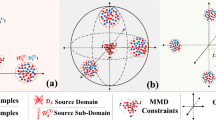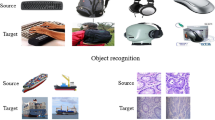Abstract
In recent years, domain adaptation methods have aroused much interest in the machine learning community which transfer labeled information from the source domain to the target domain. However, most of the domain adaptation methods require that the source domain and target domain share the same features which may limit the applications of these approaches. In the paper, we propose a novel domain adaptation approach for heterogeneous source and target domains. Our approach reconstructs each sample point using the feature line distances between the sample point and training classes. Then we build the connections between the points from the source and target domains using the reconstructed vectors. Finally, the points from the target domain are projected to label space, preserving the local geometries of the target manifold and the connections between the source and target data. Different with the general domain adaptation approaches, the labels of the unlabeled target points can be predicted automatically without using the classifiers. Results of numerical experiments illustrate the effectiveness of the proposed approach.



Similar content being viewed by others
Notes
The data set can be downloaded from http://vesicle.nsi.edu/users/patel/speech_database.html.
References
Blitzer J, Mcdonald R, Pereira F (2006) Domain adaptation with structural correspondence learning. In: Proceedings of the conference on empirical methods in natural language processing. pp 120–128
Bruzzone L, Marconcini M (2010) Domain adaptation problems: a DASVM classification technique and a circular validation strategy. IEEE Trans Pattern Anal 32(5):770–787
Belkin M, Niyogi P (2003) Laplacian eigenmaps for dimensionality reduction and data representation. Neural Comput 15(6):1373–1396
Chen M, Weinberger KQ, Blitzer J (2011) Co-training for domain adaptation. In: Proceedings of the 25th neural information processing systems (NIPS). pp 2456–2464
Yang X, Fu H, Zha H, Barlow J (2006) Semi-supervised nonlinear dimensionality reduction. In: Proceedings of the 23rd international conference on machine learning (ICML). pp 1065–1072
Daumé III H (2007) Frustratingly easy domain adaptation. In: Proceedings of the 45th association for computational linguistics (ACL). pp 256–263
Fernando B, Habrard A, Sebban M, Tuytelaars T (2013) Unsupervised visual domain adaptation using subspace alignment. In: Proceedings of the international conference on computer vision (ICCV). pp 2960–2967
Fiscus J, Doddington G, Garofolo J, Martin A (1999) NISTs 1998 Topic Detection and Tracking evaluation (TDT2). In: Proceedings of the 1999 DARPA broadcast news workshop. pp 19–24
Gong B, Shi Y, Sha F, Grauman K (2012) Geodesic flow kernel for unsupervised domain adaptation. In: Proceedings of the 25th IEEE conference on computer vision and pattern recognition (CVPR). pp 2066–2073
Gopalan R, Li R, Chellappa R (2011) Domain adaptation for object recognition: an unsupervised approach. In: Proceedings of the 13th IEEE international conference on computer vision (ICCV). pp 999–1006
Grubinger T, Birlutiu A, Schöner H, Natschläger T, Heskes T (2017) Multi-domain transfer component analysis for domain generalization. In: Neural processing letters. pp 1–11
Hong C, Yu J, You J et al (2015) Multi-view ensemble manifold regularization for 3D object recognition. Inf Sci 320(C):395–405
Hong C, Yu J, Tao D et al (2015) Image-based 3d human pose recovery by multi-view locality sensitive sparse retrieval. IEEE Trans Ind Electron 62(6):3742–3751
Hong C, Yu J, Wan J et al (2015) Multimodal deep autoencoder for human pose recovery. IEEE Trans Image Process 24(12):5659
Hull JJ (1994) A database for handwritten text recognition research. IEEE Trans Pattern Anal Intell 16(5):550–554
Jiang J, Zhai CX (2007) Instance weighting for domain adaptation in NLP. In: Proceedings of the 45th association for computational linguistics (ACL). pp 264–271
LeCun Y, Bottou L, Bengio Y, Haffner P (1998) Gradient-based learning applied to document recognition. Proc IEEE 86(11):2278–2324
Li SZ, Lu J (1998) Generalizing capacity of face database for face recognition. In: Proceedings of the 3rd IEEE international conference on automatic face and gesture recognition. pp 402–405
Pan SJ, Yang Q (2010) A survey on transfer learning. IEEE Trans Knowl Data Eng 22(10):1345–1359
Pan SJ, Kwok JT, Yang Q (2008) Transfer learning via dimensionality reduction. In: Proceedings of the 23rd conference on artificial intelligence (AAAI). pp 677–682
Pan SJ, Tsang IW, Kwok JT, Yang Q (2011) Domain adaptation via transfer component analysis. IEEE Trans Neural Netw 22(2):199–210
Pei Y, Huang F, Shi F, Zha H (2012) Unsupervised image matching based on manifold alignment. IEEE Trans Pattern Anal Intell 34(8):1658–1664
Roweis S, Saul L (2000) Nonlinear dimensionality reduction by locally linear embedding. Science 290:2323–2326
Saenko K, Kulis B, Fritz M, Darrell T (2010) Adapting visual category models to new domains. In: Proceedings of the 11st european conference on computer vision (ECCV). pp 213–226
Samanta S, Das S (2015) Unsupervised domain adaptation using manifold alignment for object and event categorization. In: Proceedings of the international conference on image processing (ICIP). pp 2739–2743
Shu L, Latecki LJ (2015) Transductive domain adaptation with affinity learning. In: Proceedings of the 24th ACM international conference on information and knowledge management (CIKM). pp 1903–1906
Sun H, Liu S, Zhou S (2016) Discriminative subspace alignment for unsupervised visual domain adaptation. Neural Process Lett 44(3):779C793
Tan M, Wang B, Wu Z et al (2016) Weakly supervised metric learning for traffic sign recognition in a LIDAR-equipped vehicle. IEEE Trans Intell Transp Syst 17(5):1415–1427
Tan M, Hu Z, Wang B et al (2016) Robust object recognition via weakly supervised metric and template learning. Neurocomputing 181:96–107
Tuia D, Camps-Valls G (2016) Kernel manifold alignment for domain adaptation. PLoS ONE 11(2):e0148655
Tuia D, Volpi M, Trolliet M, Camps-Valls G (2014) Semisupervised manifold alignment of multimodal remote sensing images. IEEE Trans Geosci Remote Sens 52(12):7708–7720
Wang C, Mahadevan S (2009) Manifold alignment without correspondence. In: Proceedings of the 21st international joint conference on artificial intelligence (IJCAI). pp 1273–1278
Wang C, Mahadevan S (2011) Heterogeneous domain adaptation using manifold alignment. In: Proceedings of the 22nd international joint conference on artificial intelligence (IJCAI). pp 1541–1546
Wu C, Shi X, Su J, Chen Y, Huang Y (2017) Co-training for implicit discourse relation recognition based on manual and distributed features. Neural Process Lett 46(1):233–250
Wu T, Chen K (2002) On the use of nearest feature line for speaker identification. Pattern Recognit Lett 23(14):1735–1746
Wang J, Zhang X, Li X, Du J (2017) Semi-supervised manifold alignment with few correspondences. Neurocomputing 230:322–331
Xiao M, Guo Y (2012) Semi-supervised kernel matching for domain adaptation. In: Proceedings of the 26th conference on artificial intelligence (AAAI). pp 1183–1189
Zhang H, Ji H, Wang X (2012) Transfer learning from unlabeled data via neural networks. Neural Process Lett 36(2):173C187
Zhang Z, Zha H (2005) Principal manifolds and nonlinear dimensionality reduction via tangent space alignment. SIAM J Sci Comput 26(1):313–338
Zhu Y, Chen Y, Lu Z, Pan SJ, Xue GR, Yu Y, Yang Q (2011) Heterogeneous transfer learning for image classifcation. In: Proceedings of the 25th conference on artificial intelligence (AAAI). pp 1304–1309
Acknowledgements
The work of this author was supported in part by NSFC (61370006, 61673186), NSF of Fujian Province 2014J01237, and The Postgraduate Scientific Research Innovation Ability Training Plan Funding Projects of Huaqiao University (1511314004).
Author information
Authors and Affiliations
Corresponding author
Rights and permissions
About this article
Cite this article
Wang, J., Li, X. & Du, J. Label Space Embedding of Manifold Alignment for Domain Adaption. Neural Process Lett 49, 375–391 (2019). https://doi.org/10.1007/s11063-018-9822-8
Published:
Issue Date:
DOI: https://doi.org/10.1007/s11063-018-9822-8




